Exploring the Effects of LED-Based Visible Light Communication on Reading and Color Perception in Indoor Environments: An Experimental Study
Abstract
1. Introduction
2. Experimental Setup
3. Psycho-Physical Tests Used during Experimental Campaign
3.1. Reading Tests
3.1.1. Reading Explorer Test (REX Test)
3.1.2. Radner Reading Test
3.2. Color Vision Tests
3.2.1. Ishihara Color Test
3.2.2. City University Colour Vision Test
3.2.3. Farnsworth–Munsell 100 Hue Colour Vision Test
4. Experimental Results
4.1. Reading Tests
4.2. Colour Vision Tests
5. Conclusions
Author Contributions
Funding
Institutional Review Board Statement
Informed Consent Statement
Data Availability Statement
Conflicts of Interest
References
- Mucchi, L.; Jayousi, S.; Caputo, S.; Panayirci, E.; Shahabuddin, S.; Bechtold, J.; Morales, I.; Stoica, R.A.; Abreu, G.; Haas, H. Physical-Layer Security in 6G Networks. IEEE Open J. Commun. Soc. 2021, 2, 1901–1914. [Google Scholar] [CrossRef]
- Mohsan, S.A.H.; Mazinani, A.; Sadiq, H.B.; Amjad, H. A survey of optical wireless technologies: Practical considerations, impairments, security issues and future research directions. Opt. Quantum Electron. 2022, 54, 187. [Google Scholar] [CrossRef]
- Rehman, S.; Ullah, S.; Chong, P.; Yongchareon, S.; Komosny, D. Visible Light Communication: A System Perspective—Overview and Challenges. Sensors 2019, 19, 1153. [Google Scholar] [CrossRef] [PubMed]
- Caputo, S.; Mucchi, L.; Umair, M.A.; Meucci, M.; Seminara, M.; Catani, J. The Role of Bidirectional VLC Systems in Low-Latency 6G Vehicular Networks and Comparison with IEEE802.11p and LTE/5G C-V2X. Sensors 2022, 22, 8618. [Google Scholar] [CrossRef] [PubMed]
- Rahman, A.B.M.M.; Li, T.; Wang, Y. Recent Advances in Indoor Localization via Visible Lights: A Survey. Sensors 2020, 20, 1382. [Google Scholar] [CrossRef] [PubMed]
- Do, T.H.; Yoo, M. An in-Depth Survey of Visible Light Communication Based Positioning Systems. Sensors 2016, 16, 678. [Google Scholar] [CrossRef] [PubMed]
- IEEE Std 802.15.7-2011; IEEE Standard for Local and Metropolitan Area Networks—Part 15.7: Short-Range Wireless Optical Communication Using Visible Light. IEEE: New York, NY, USA, 2011; pp. 1–309. [CrossRef]
- Do, T.H.; Yoo, M. Performance Analysis of Visible Light Communication Using CMOS Sensors. Sensors 2016, 16, 309. [Google Scholar] [CrossRef] [PubMed]
- IEEE Std 1789-2015; IEEE Recommended Practices for Modulating Current in High-Brightness LEDs for Mitigating Health Risks to Viewers. IEEE: New York, NY, USA, 2015; pp. 1–80. [CrossRef]
- Yoshizawa, S.; Handa, S.; Sasamori, F.; Takyu, O. A simple but effective approach for visible light beacon-based positioning systems with smartphone. In Proceedings of the 2016 IEEE 12th International Colloquium on Signal Processing & Its Applications (CSPA), Melaka, Malaysia, 4–6 March 2016; pp. 32–35. [Google Scholar] [CrossRef]
- Lartigue, C.; Green, J.; Pérez-Olivas, H.; García-Márquez, J.; Topsu, S. High-efficient manchester coding for beacon-to-CMOS camera in visible light communications. In Proceedings of the 2018 Global LIFI Congress (GLC), Paris, France, 8–9 February 2018; pp. 1–4. [Google Scholar] [CrossRef]
- Zhang, F.; Qiu, K.; Liu, M. Asynchronous blind signal decomposition using tiny-length code for Visible Light Communication-based indoor localization. In Proceedings of the Robotics and Automation (ICRA) 2015 IEEE, Seattle, WA, USA, 26–30 May 2015; pp. 2800–2805. [Google Scholar] [CrossRef]
- Asai, T.; Yendo, T.; Arai, S.; Yamazato, T.; Okada, H.; Fujii, T.; Kamakura, K. Position estimation of LED matrix in image sensor communication. In Proceedings of the 2016 Asia-Pacific Signal and Information Processing Association Annual Summit and Conference (APSIPA), Jeju, Republic of Korea, 13–16 December 2016; pp. 1–5. [Google Scholar] [CrossRef]
- Zhou, Z.; Lin, B.; Tang, X.; Chaudhary, S.; Lin, C.; Zhang, H. Performance comparison of DFT-OFDM, DCT-OFDM, and DWT-OFDM for visible light communications. In Proceedings of the 17th International Conference on Optical Communications and Networks (ICOCN2018), Zhuhai, China, 16–19 November 2018; Li, Z., Ed.; SPIE: Bellingham, WA, USA, 2019. [Google Scholar] [CrossRef]
- Ahmed, Z.; Ali, W.; Faulkner, G.; Collins, S. A comparison of VLC receivers that incorporate two different SiPMs. IEEE Photonics J. 2023, 1–8. [Google Scholar] [CrossRef]
- Wang, F.; Yang, F.; Song, J.; Han, Z. Access Frameworks and Application Scenarios for Hybrid VLC and RF Systems: State of the Art, Challenges, and Trends. IEEE Commun. Mag. 2022, 60, 55–61. [Google Scholar] [CrossRef]
- Le, N.T.; Hossain, M.A.; Jang, Y.M. A survey of design and implementation for optical camera communication. Signal Process. Image Commun. 2017, 53, 95–109. [Google Scholar] [CrossRef]
- Available online: https://industry-electronics.de/pdf/659709.pdf (accessed on 10 February 2019).
- Dahri, F.A.; Ali, S.; Jawaid, M.M. A Review of Modulation Schemes for Visible Light Communication. IJCSNS 2018, 18, 117. [Google Scholar]
- Giacomelli, G.; Volpe, R.; Virgili, G.; Farini, A.; Arrighi, R.; Tarli-Barbieri, C.; Mencucci, R.; Menchini, U. Contrast reduction and reading: Assessment and reliability with the Reading Explorer test. Eur. J. Ophthalmol. 2010, 20, 389–396. [Google Scholar] [CrossRef] [PubMed]
- Radner, W.; Willinger, U.; Obermayer, W.; Mudrich, C.; Velikay-Parel, M.; Eisenwort, B. A new reading chart for simultaneous determination of reading vision and reading speed. Klin. Monatsblatter Fur Augenheilkd. 1998, 213, 174–181. [Google Scholar] [CrossRef] [PubMed]
- Radner, W.; Diendorfer, G. English sentence optotypes for measuring reading acuity and speed—the English version of the Radner Reading Charts. Graefe’s Arch. Clin. Exp. Ophthalmol. 2014, 252, 1297–1303. [Google Scholar] [CrossRef] [PubMed]
- Ishihara, S. Ishihara’s Tests for Colour Deficiency: 24 Plates; Kanehara Shuppan: Tokyo, Japan, 1969. [Google Scholar]
- Fletcher, R. The City University Colour Vision Test; Keeler: Windsor, UK, 1980. [Google Scholar]
- Farnsworth, D. The Farnsworth–Munsell100-hue and dichotomous tests for color vision. JOSA 1943, 33, 568–578. [Google Scholar] [CrossRef]
- Birch, J. Use of the Farnsworth—Munsell 100-Hue test in the examination of congenital colour vision defects. Ophthalmic Physiol. Opt. 1989, 9, 156–162. [Google Scholar] [CrossRef] [PubMed]
- Verriest, G.; Van Laethem, J.; Uvijls, A. A new assessment of the normal ranges of the Farnsworth-Munsell 100-hue test scores. Am. J. Ophthalmol. 1982, 93, 635–642. [Google Scholar] [CrossRef] [PubMed]
- Brysbaert, M. How many words do we read per minute? A review and meta-analysis of reading rate. J. Mem. Lang. 2019, 109, 104047. [Google Scholar] [CrossRef]
- Bland, J.M.; Altman, D. Statistical methods for assessing agreement between two methods of clinical measurement. Lancet 1986, 327, 307–310. [Google Scholar] [CrossRef]
- Finney, D.J. The Fisher-Yates test of significance in 2 × 2 contingency tables. Biometrika 1948, 35, 145–156. [Google Scholar] [PubMed]
- Caputo, S.; Biotti, L.; Mucchi, L. Bio-Optical Communication. In Proceedings of the Eight Annual ACM International Conference on Nanoscale Computing and Communication, Catania, Italy, 7–9 September 2021. [Google Scholar] [CrossRef]

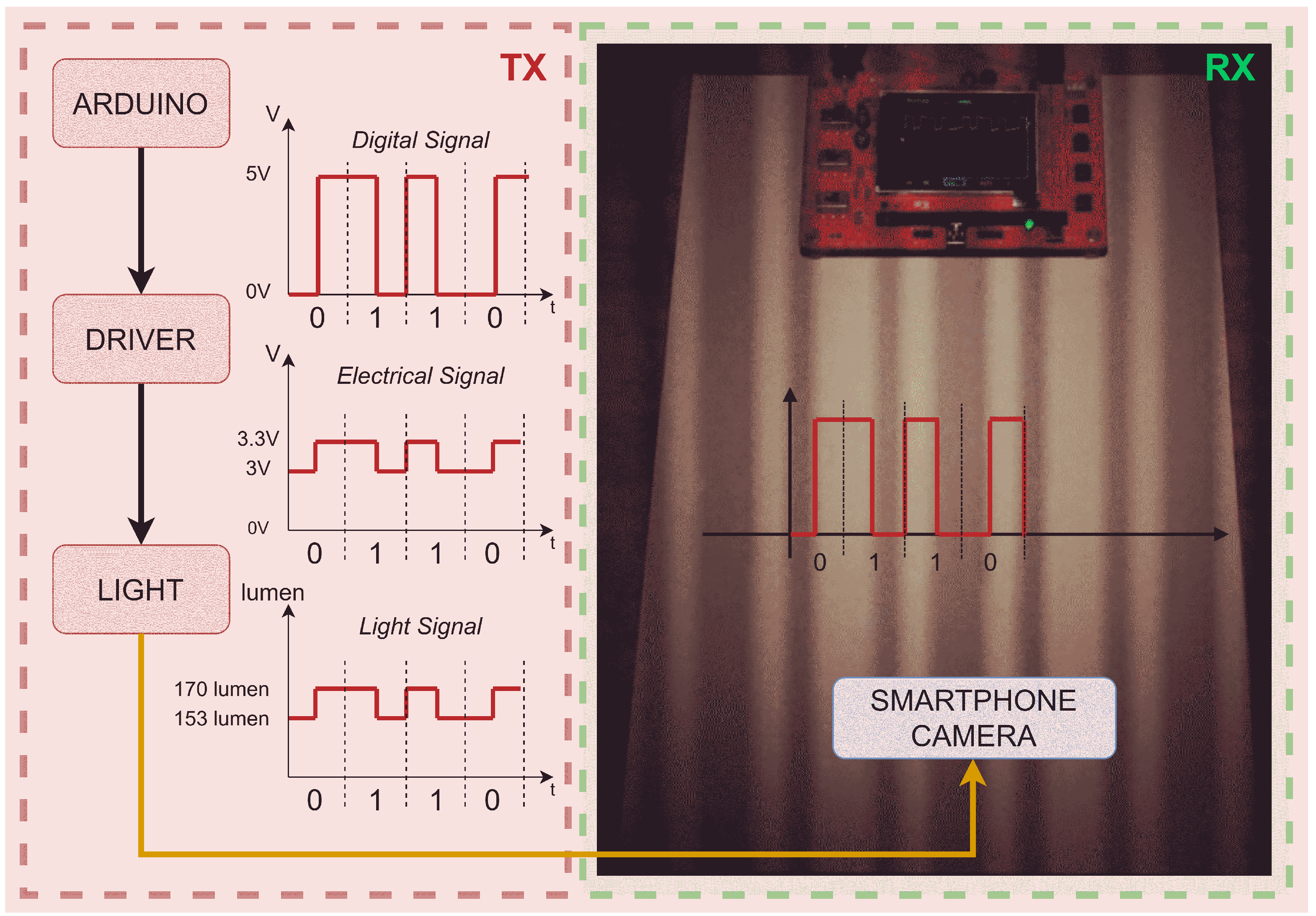

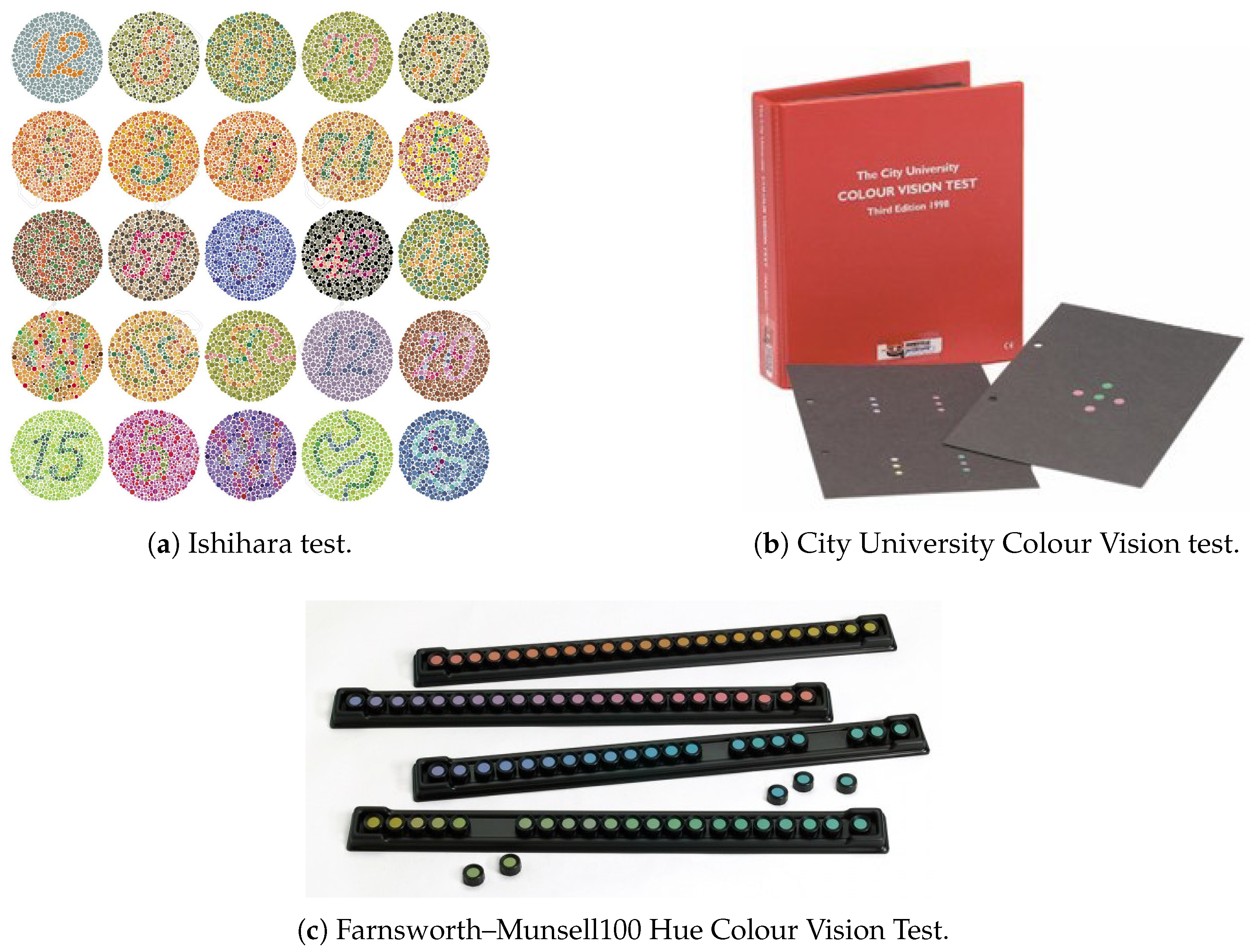
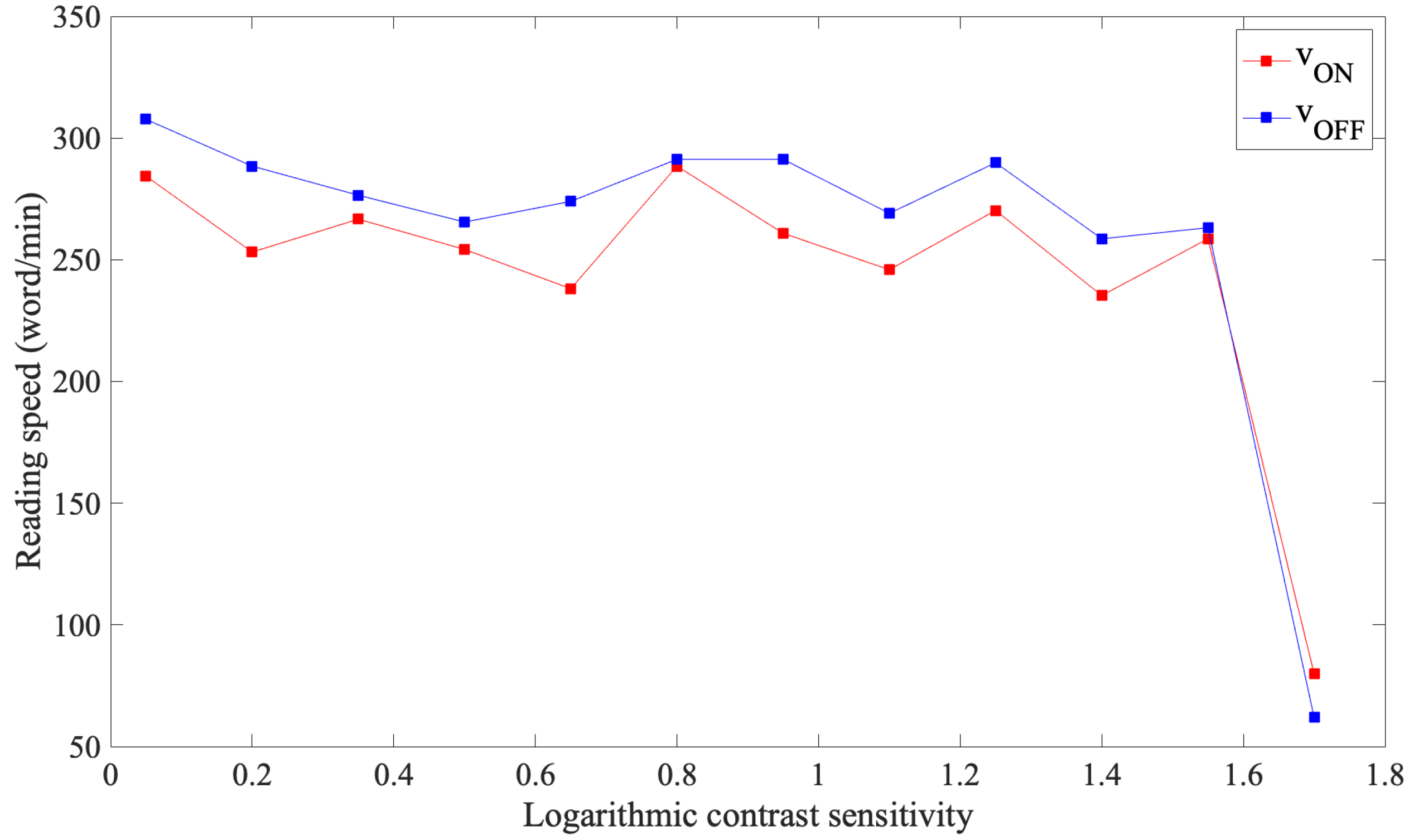

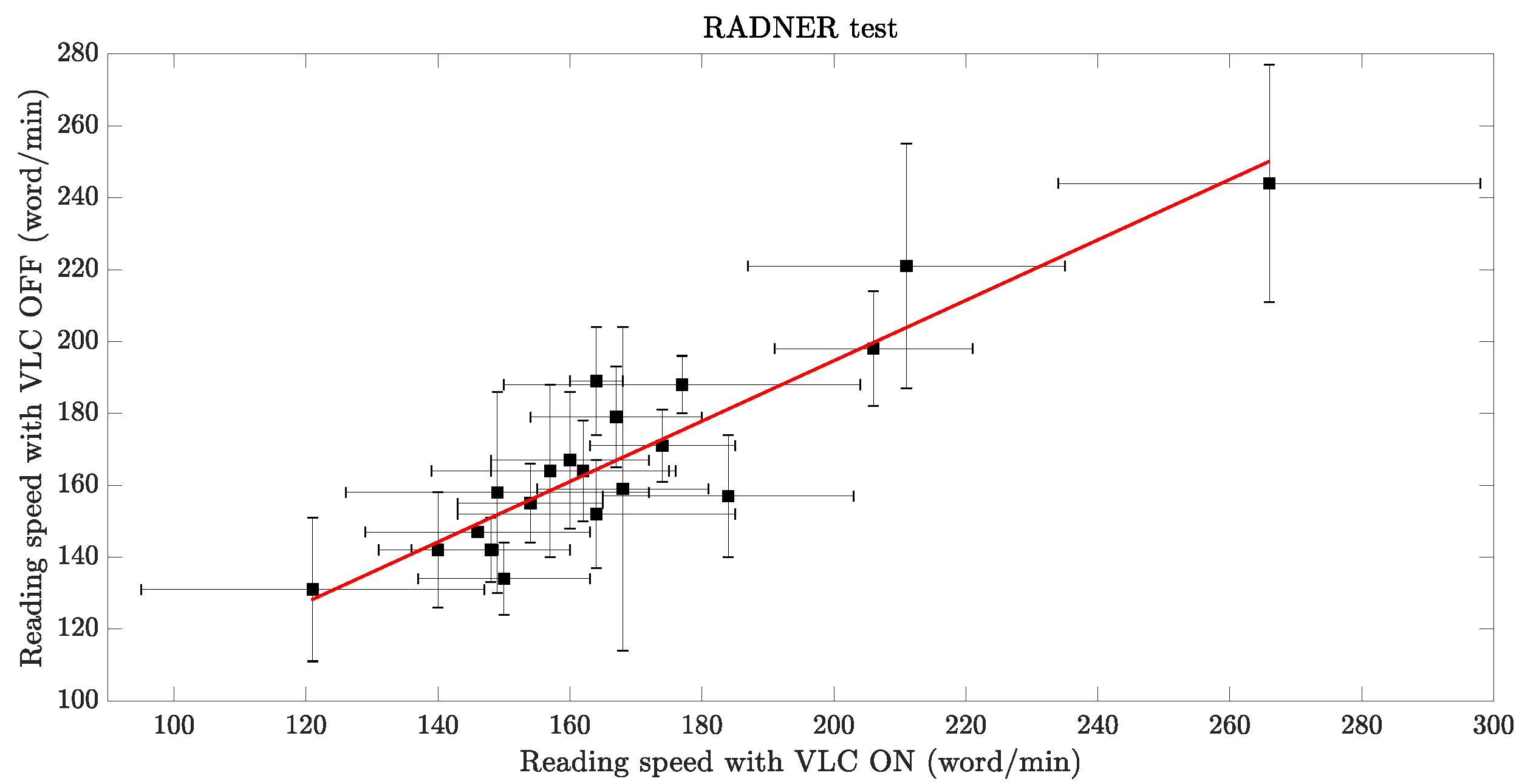

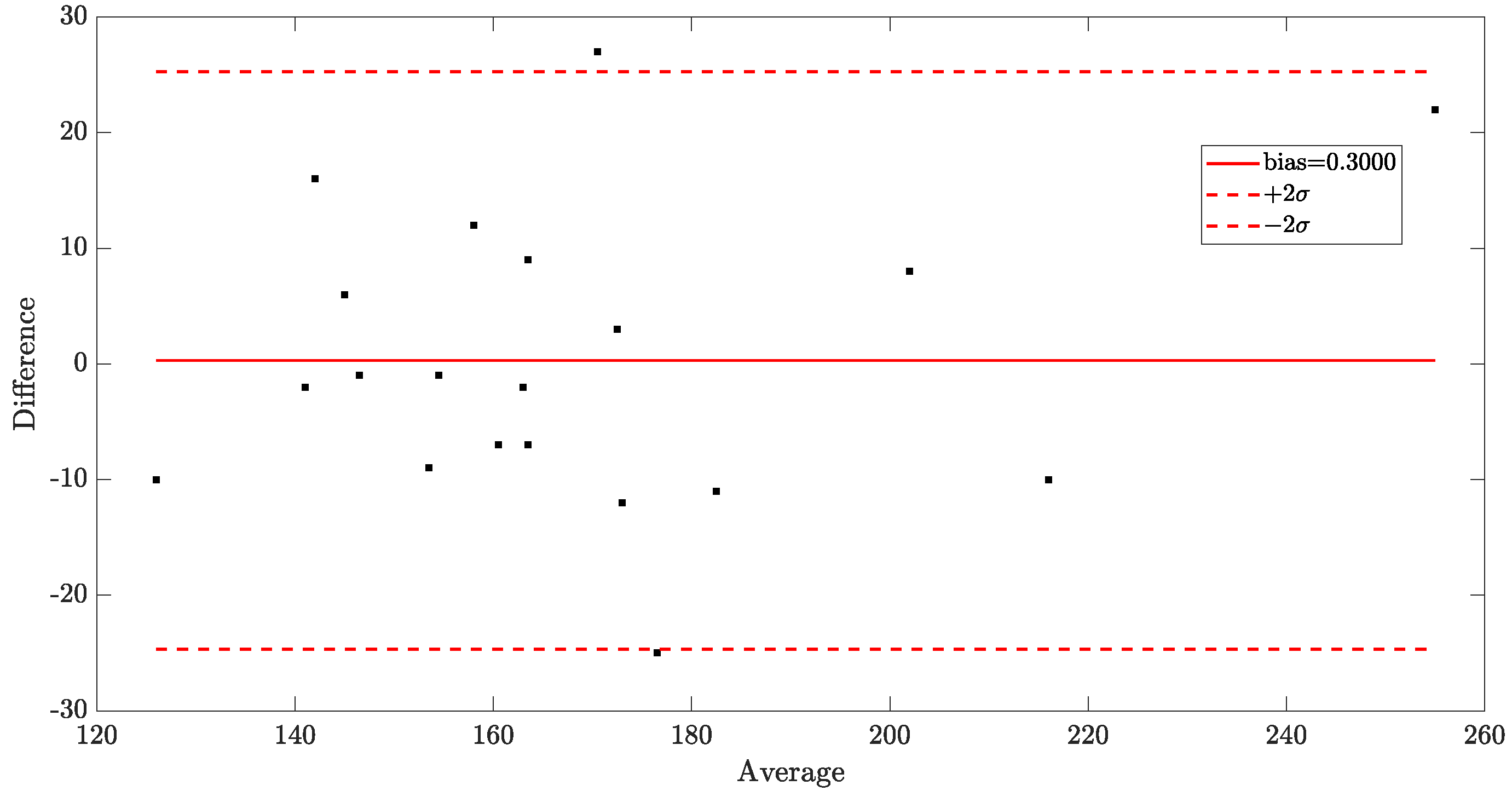



Disclaimer/Publisher’s Note: The statements, opinions and data contained in all publications are solely those of the individual author(s) and contributor(s) and not of MDPI and/or the editor(s). MDPI and/or the editor(s) disclaim responsibility for any injury to people or property resulting from any ideas, methods, instructions or products referred to in the content. |
© 2023 by the authors. Licensee MDPI, Basel, Switzerland. This article is an open access article distributed under the terms and conditions of the Creative Commons Attribution (CC BY) license (https://creativecommons.org/licenses/by/4.0/).
Share and Cite
Caputo, S.; Mucchi, L.; Comparetto, R.; D’Antoni, V.; Farini, A.; Orsi, V.; Baldanzi, E. Exploring the Effects of LED-Based Visible Light Communication on Reading and Color Perception in Indoor Environments: An Experimental Study. Sensors 2023, 23, 2949. https://doi.org/10.3390/s23062949
Caputo S, Mucchi L, Comparetto R, D’Antoni V, Farini A, Orsi V, Baldanzi E. Exploring the Effects of LED-Based Visible Light Communication on Reading and Color Perception in Indoor Environments: An Experimental Study. Sensors. 2023; 23(6):2949. https://doi.org/10.3390/s23062949
Chicago/Turabian StyleCaputo, Stefano, Lorenzo Mucchi, Regina Comparetto, Vittoria D’Antoni, Alessandro Farini, Valentina Orsi, and Elisabetta Baldanzi. 2023. "Exploring the Effects of LED-Based Visible Light Communication on Reading and Color Perception in Indoor Environments: An Experimental Study" Sensors 23, no. 6: 2949. https://doi.org/10.3390/s23062949
APA StyleCaputo, S., Mucchi, L., Comparetto, R., D’Antoni, V., Farini, A., Orsi, V., & Baldanzi, E. (2023). Exploring the Effects of LED-Based Visible Light Communication on Reading and Color Perception in Indoor Environments: An Experimental Study. Sensors, 23(6), 2949. https://doi.org/10.3390/s23062949









